External trade - 3 quarter
Product Code: q-6032-09
External trade 1 showed in the first three quarters of 2009 a marked shrinking 2 , which has never been observed in the history of the self-dependent Czech Republic. The decrease of exports and namely imports in comparison with 1 st to 3 rd quarters 2008 led to y-o-y decrease of the external trade turnover by 18,8 % (in the first three quarters of 2008 there was an increase by 4,2 % compared with same period of 2007). Thus the value of external trade turnover returned to the level, or became even slightly lower, than in the first three quarters of 2006. The external trade balance reached in the first three quarters of 2009 the highest surplus 3 (CZK 117,7 billion) since 2005, which was the first year since the creation of the Czech Republic, which brought a positive balance 4 that remained characteristic for all coming years.
In Q1-Q3 2009, compared to Q1-Q3 2008:
- Exports decreased by 17,5 % (CZK 333,3 billion) and reached CZK 1589,6 billion, imports decreased by 20,2 % (CZK 368,4 billion) and reached 1451,9 billion. In the 3 rd quarter the decrease of both exports and imports slightly moderated, compared with the two preceding quarters. The y-o-y shrinking by CZK 707,1 billion was by 47,5 % due to the decrease of exports and by 52,5 % to that of imports. Due to a marked depreciation of CZK against EUR and even more against USD 5 , exports and imports in these currencies decreased in the y-o-y comparison more rapidly than in CZK. Converted in EUR, exports and imports decreased by 23,0 and 25,6 %, in USD the decrease was 30,9 and 33,2 %;
- Trade balance surplus grew by CZK 35,1 billion and reached CZK 117,7 billion. The rate of coverage of imports by exports was 108,1 % against 104,5 % in Q1-Q3 2008. The positive balance reached in the 3 rd quarter itself CZK 40,6 billion against CZK 43,8 billion in the 2nd quarter and CZK 33,4 billion in the first one. By group of countries, the main cause of the trade balance improvement was the y-o-y lower deficit by CZK 58,0 billion of the external trade with non-EU countries, because the surplus of trade balance with EU states decreased y-o-y by CZK 22,9 billion. The positive balance with EFTA states decreased by CZK 7,4 billion and with the European transition economies by CZK 3,1 billion. The negative balance with CIS 6 countries was lower by CZK 37,3 billion, with developing economies by CZK 11, 4 billion, with other developed market economies by CZK 9,6 billion and with other states 7 by CZK 15,5 billion. By commodity section, trade balance surplus improved in manufactured goods classified chiefly by material by CZK 16,0 billion and deteriorated in machinery and transport equipment by by CZK 28,0 billion and in miscellaneous manufactured articles by CZK 4,9 billion. A significant moderation of the deficit was registered in the external trade with crude materials, inedible, and mineral fuels by CZK 49,1 billion and chemicals by CZK 6,9 billion, an increase of deficit by CZK 3,9 billion was evident in agricultural and food crude materials and products;
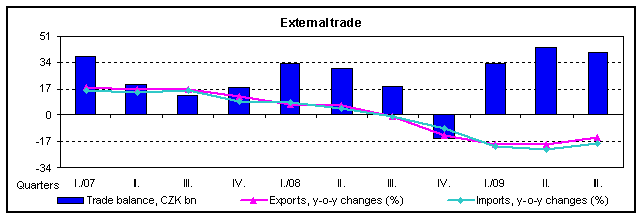
- By group of countries, the share of trade with EU-27 countries in total exports slightly increased (from 85,5 % to 85,6 %) and the same share of total imports decreased from 68,0% to 67,4 %. An increase of the in total exports was evident for EFTA countries (from 1,9 % to 2,2 %), developing economies (from 3,2 to 4,0 %) and for other states (from 0,6 to 0,7 %); CIS, European economies in transition and the developed market economies weakened their position from 4,2 % to 3,3 %, from 0,9 % to 0,8 % and from 3,5 % to 3,4 %. In total imports, EFTA countries raised their share from 1,5 % to 2,3 %, other developed market economies from 6,7 % to 6,9 %, developing economies from 5,9 % to 6,6 % and the greatest increase was registered for other countries (from 8,5 % to 9,5 %). The share of CIS decreased from 8,8 % to 6,7 % and that of European economies in transition from 0,4 % to 0,3 %;
- By commodity section, the share of machinery and transport equipment in total exports in total exports decreased from 53,8 % to 53,1 % and the share of manufactured material from 19,8 % to 18,2 %; an increase of the share was observed in agricultural and food crude materials and products (from 3,7 % to 4,5 %, in chemical products (from 6,0 to 6,2 %), in crude materials, inedible, and mineral fuels (from 6,0 % to 6,1 %) and in manufactured goods classified chiefly by material (from 10,5 % to 11,8 %). In the total imports the share of machinery and transport equipment decreased from 41,2 % to 40,5 %, manufactured goods chiefly classified by material from 20,3 % to 18,1 % and crude materials, inedible, and mineral fuels from 12,8 % to 11,3 %. The share increased in agriculture and food crude materials and products from 4,9 % to 6,4 %, in chemical products from 10,5 to 11,6 % and in miscellaneous manufactured articles from 10,5 % to 12,1 %.
External trade figures for Q1-Q3 2009 were affected by:
- Continuing decrease of industrial production, which affected almost all branches of the manufacturing industry. The decrease of production had a negative influence on total exports. In Q1-Q3 2009, compared to the same period of 2008, exports of manufacturing industry 8 decreased by 18,4 % (CZK 338,3 billion) and its share in total exports decreased from 96,4 to 95,3 %. Exports of manufacturing industry products were dominated by machinery and transport equipment, namely road vehicles, electrical machinery, general industrial machinery and equipment and telecommunications equipment. The share of road vehicles in total exports was 17,0 % in Q1-Q3 2009 (16,3 % in Q1-Q3 2008), of which passenger cars 9,3 % and motor vehicles equipment 6,7 %. The surplus of external trade with road vehicles (CZK 149,2 billion) in Q1 – Q3 2009 was the highest among all SITC classes, but lower by CZK 2,9 billion in the y-o-y comparison (the decrease was CZK 6,6 billion in passenger cars and CZK 21,9 in motor vehicles equipment).

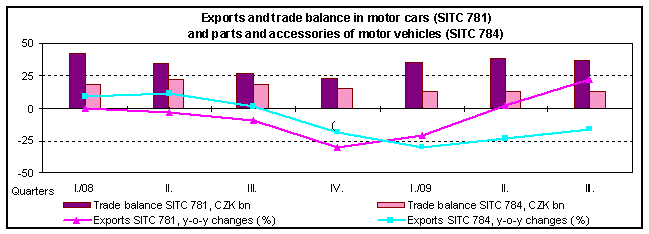
On the second position in the surplus rank of the machinery trade and simultaneously of the total external trade (CZK 30,8 billion, which was however a y-o-y decrease by CZK 8,1 billion) was observed in general industry machinery and equipment;
- Low external demand, caused by the world financial and economic crisis. It was primarily the shrinking of the economies of EU states and the accompanying of the investors and consumer demand, which affected the development of external trade of the Czech Republic in a negative way. In the 1 st half-year 2009, compared to the 1 st half-year of 2008, the EU GDP decreased almost by 5 %. This was caused namely by the shrinking of German economy (by more than 6 % in the same period), which is the key market for Czech enterprises and which in a great extent predestined the development of Czech exports. In Q1 – Q3 2009, Czech exports to Germany decreased y-o-y by 11,5 %.
- Favourable development of terms of trade 9 . The development of external trade prices was affected by the price development on the world market and by changing relation of CZK to EUR and USD. In January to August 2009, compared with the same period of 2008, exports prices increased by 2,2 % in the average, prices of imports increased by 1,9 %; so the terms of trade reached the positive value 104,2 and had therefore a positive impact on the external trade balance at current prices. In the mentioned period, exports at current prices decreased by 18,0 % and exports by 20,5 %, in real terms exports decreased by 19,5 % and imports by 19,7 %. In January to August 2009, prices pushed up exports at current prices by more than CZK 23 billion and pushed down exports at current prices by CKK 13 billion. The external trade surplus was in real terms by more than CZK 36 billion lower than the positive balance at current prices.
A more detailed view of the territorial structure of external trade in Q1 – Q3 2009 unambiguously shows, that in the y-o-y comparison:
- Exports to all territories, except developing economies, decreased. Exports to EU states, decreased by 17,4 % (CZK 283,6 billion), exports to non-EU countries by 18,5 % (CZK 107,8 billion). The greatest y-o-y relative decrease was observed for exports to CIS and European economies in transition, further to other developed market economies EFTA countries and other states. Exports to developing economies increased by 1,5 %. The decrease of exports to EU was a result of a decrease to all countries of this group. The largest decrease occurred in exports to Germany (CZK 67,6 billion), then to Poland (CZK 31,0 billion), to Slovakia (CZK 30,8 billion) and Italy (CZK 18,1 billion). Among other states we can name the decrease of exports to Russia (CZK 15,8 billion), to Ukraine (CZK 9,9 billion) and to USA (CZK 7,6 billion). Exports to Norway increased by CZK 2,3 billion and to Turkey by CZK 1,5 billion;
- Imports from all territories, except EFTA countries, decreased. Imports from EU states decreased by 21,0 % (CZK 260,7 billion) and to non–EU countries by 18,5 % (CZK 107,8 billion). The most marked relative decrease was observed at imports from CIS and European economies in transition, further from other developed market economies, other states and developing economies.. Exports from EFTA countries increased by 21,3 %. The decrease of total imports from EU was due to a decrease of imports from all EU states except Malta, Latvia, Ireland and Portugal. Perceivable was the shrinking in imports from Germany (CZK 111,1 billion) and Slovakia (CZK 22,2 billion). Among non-EU countries imports decreased namely from Russia (CZK 38,6 billion), China (CZK 16,2 billion and Japan (CZK 12,8 billion). On the other hand, imports from Norway increased (by CZK 8,2 billion).
- External trade surplus was higher. Positive trade balance with EU states reached CZK 365,8 billion, deficit with non-EU countries was CZK 248,0, caused by a negative balance with other states (CZK 127,5 billion), CIS (CZK 44,7 billion), other developed market economies (CZK 47,1 billion) and developing economies (CZK 33,6 billion). European economies in transition and EFTA countries softened down the total trade balance with non-EU countries by the surplus of CZK 7,9 million and 1,5 billion.
Trade balance and its y-o-y changes for particular groups of countries were due to the development of the trade balance with partner states. The total external trade surplus was namely affected by the positive balance with five states (Germany, Slovakia, UK, France and Austria). Within the total deficit of the balance with non-EU states, CZK 208,7 billion against CZK 258,0 billion in Q1-Q3 2008) fell on three states (China, Russia and Japan).
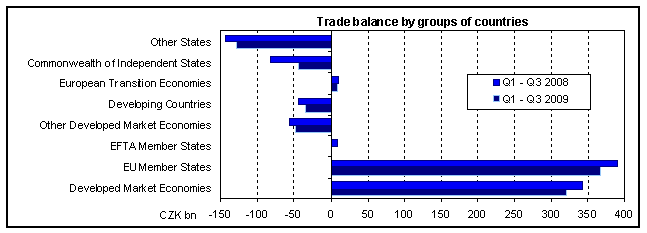
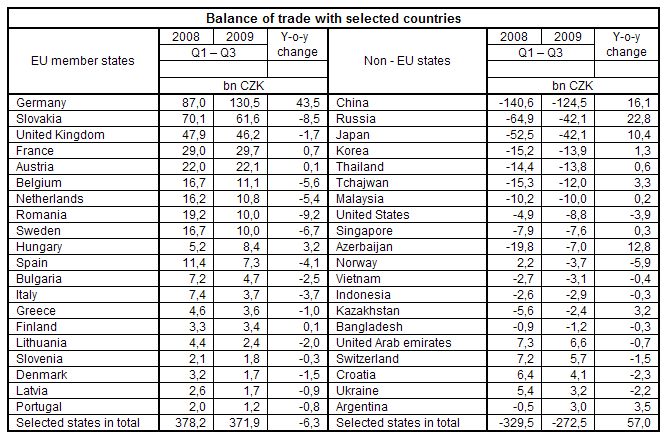
Changes in commodity structure of the external trade were marked in Q1-Q3 2009, compared to the same period of 2008, by decrease of both exports and imports in an overwhelming majority of SITC classes. Compared to Q1-Q3 2008, following changes were observed in Q1-Q3 2009:
- Machinery and transport equipment a shrinking of exports by 18,6 % (CZK 190,1 billion and imports by 21,6 % (CZK 162,1 billion). The decrease of the value of exports and imports was the highest among all SITC classes and brought a marked affection of the overall shrinking of external trade. The positive balance of external trade with machinery and transport equipment reached CZK 246,5 billion against CZK 274,5 billion in Q1-Q3 2008 (with EU states CZK 341,7 billion against CZK 367,1 billion). Surplus of trade balance was registered, except electrical equipment (whose balance ended with a deficit of CZK 0,6 billion against a surplus CZK 16,8 billion in Q1-Q3 2008) for all other machinery groups. The highest active balance was evident for road vehicles, then for manufacture of machinery and equipment, telecommunications and sound-recording and reproduction apparatus and equipment, office machines and automatic data-processing machinery and other transport equipment;
- Manufactured goods classified chiefly by material showed a decrease of exports by 24,1 % and imports by 28,9 %. The positive balance of these products reached CZK 22,8 billion from CZK 6,8 billion in Q1-Q3 2008. The improvement of trade balance was due primarily to a lower deficit in trade with non-ferrous metals by CZK 14,8 billion and with iron and steel by CZK 10,5 billion. The largest surpluses are to be found in the trade with metallic manufactures, non-metallic manufactures and rubber manufactures.
-
- Miscellaneous manufactured articles registered a decrease of exports by 7,5 % and imports by 5,1 % and a decrease of the external trade surplus by CZK 4,9 billion. A positive balance was observed in miscellaneous products, furniture and parts thereof, prefabricated buildings and sanitary techniques manufactures, scientific and control apparatus and equipment and other transport equipment;
- Chemicals and related products showed lower exports by 14,3 % and imports by 12,1 %. The negative balance of this trade was the highest (CZK 70,1 billion against CZK 77,0 billion in Q1-Q3 2008) among all SITC classes. A big deficit continued in medicinal and pharmaceutical products; its y-o-y increase was CZK 1,7 billion. The deficit decreased in plastics in primary form by CZK 4,5 billion, in fertilizers by CZK 2,8 billion, chemical materials and products by CZK 2,7 billion and plastics in non-primary forms by CZK 1,2 billion;
- - Crude materials, inedible, and mineral fuels, shrinking of exports by 17,2 % and namely of imports by 29,4 %.Trade deficit decreased by CZK 49,1 billion and was the second highest (CZK 69,9) billion among all SITC classes. This decrease was the result of the decrease of the deficit of trade in petroleum, petroleum products and related materials by CZK 34,3 billion. Imports in this item were y-o-y lower by 38,9 % (imports of petroleum themselves decreased by 2,7 % in volume and by 41,4 % in value). The balance of trade in crude materials, inedible, and mineral fuels was negatively affected by the deepening of deficit of trade in gas, natural and manufactured by 5,9 % (imports of natural gas themselves decreased by 10,6 % in volume and by 7,3 % in value) and by a decrease of surplus of trade in coal, coke and briquettes by CZK 4,0 billion. A positive influence had the increase of the increase of surplus of the trade in electric current, transition from deficit to surplus in metalliferous ores and metal scrap and a lasting surplus in trade with cork and wood manufactures;
- Agricultural an food crude materials and products, decrease of exports by 1,4 % and, as the only SITC class, growth of imports by 3,3 %. Deficit of balance of trade in these products was y-o-y higher by CZK 4,0 billion. The highest deficit brought the trade in vegetables and fruit and meat and meat preparations. The surplus of trade with cereals and cereal preparations grew by CZK 2,2 billion and decreased in trade with tobacco and tobacco manufactures by CZK 1,0 billion and decreased by CZK 1,8 billion in dairy products.
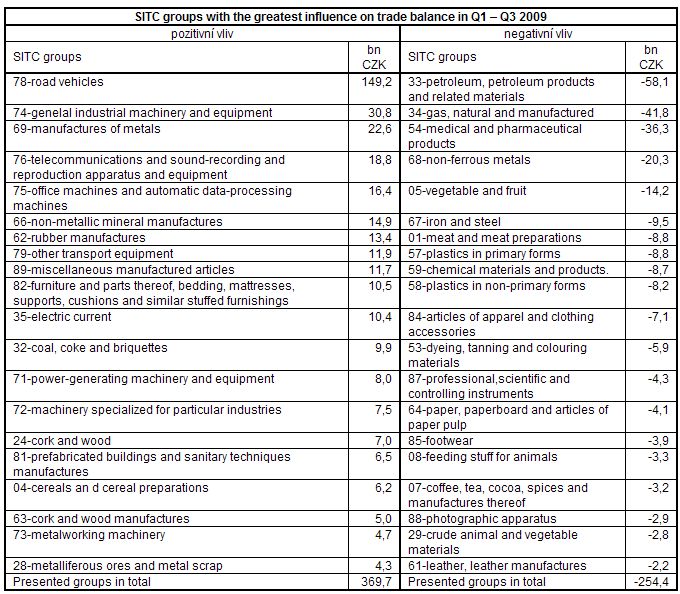
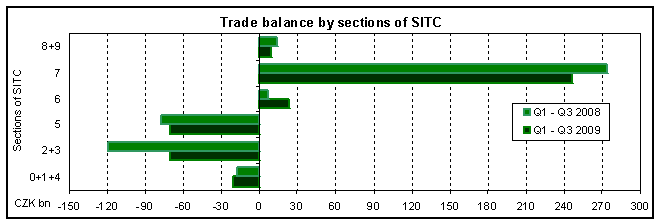
| Sections of SITC, Rev. 4 | Sections of SITC, Rev. 4 | ||
| 0+1+4 | Agricultural and food crude materials and products | 6 | Manufactured goods classified chiefly by material |
| 2+3 | Crude materials, inedible, and mineral fuels | 7 | Machinery and transport equipment |
| 5 | Chemicals and related products | 8+9 | Miscellaneous manufactured articles, commodities and transactions not classified elsewhere in the SITC |
o - o - o
On October 16, 2009, Eurostat published data on external trade of EU countries for January to July 2009. All EU states registered a double figure decrease of external trade, compared to the same period of 2008. The y-o-y decrease of exports of the Czech Republic was, compared to the decrease of the EU total and new member states total rather higher, the y-o-y decrease of imports was in relation to the EU total more marked and in relation to the total of new member states more moderate. In January to July 2009, exports of EU on the EUR base decreased y-o-y by 24,1 % and imports by 30,6 % in average. The share of 12 new EU member states in total EU exports weakened to 10,8 % from 11,0 % in the same period of 2008, their share in EU exports reached 11,4 % against 12,4 % in the same period of 2008. The EU trade balance ended in January to July 2009with a deficit of EUR20,0 billion and the deficit of 12 new member states reached EUR 13,0 billion, which was, y-o-y, by EUR 30,7 billion lower. Czech Republic reached (as well as other 10 EU states) a trade balance surplus. Among new member states, a surplus was reached also in Hungary (EUR 2,6 billion) and Slovenia (EUR 0,2 billion).
1 All data are in current prices. Data for year 2008 are finalized and refer to 28 August 2009 closing date. Data for 2009 are updated for January-June and preliminary for July referring to 28 September 2009, data for August are preliminary referring to 29 September 2009 and for September preliminary referring to 29 October 2009. The data come from basic units and then rounded, which may give rise to discrepancies.
2 Another, much more moderate decrease of external trade turnover, by 3,3% compared with the preceding year (exports decreased by 1,4 %, imports by 5,1 %), occurred in the 1 st to 3 rd quarters 2002.
3 In the first to third quarters of 2008, the positive balance amounted to CZK 82,6 billion.
4 In the 1 st to 3 rd quarters of 2005 the surplus of the trade balance reached CZK 37,4 billion.
5 During the first 3 quarters of 2009, CZK weakened by 6,8 % against EUR and by 16,5 % against USD.
6 The Commonwealth of Independent States.
7 China, North Korea, Laos, Mongolia and Vietnam.
8 Items CZ 15 to CZ-CPA 36.
9 Price indices of exports and imports are published one month later than data on external trade of the Czech Republic

